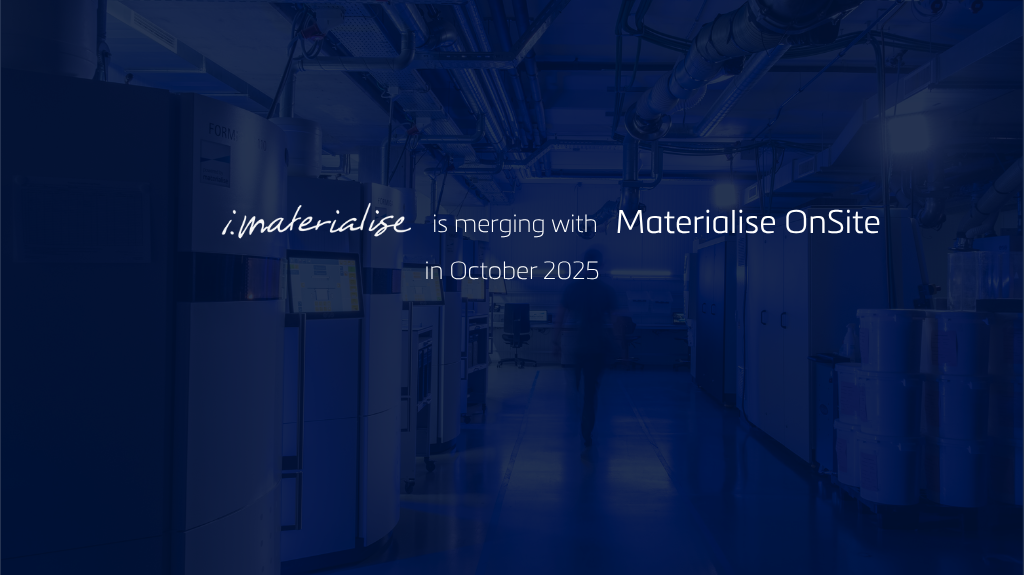Who is (y)our Website Manager?
I’m Franky, a 30 years old and I’m the website manager of i.materialise. I wireframe, do some graphical design, occasionally write requirements for our developers, find interesting topics to blog about, take photos of all the nice things you design, make videos…and more. I love to talk about 3D printing, it’s fascinating and everyone deserves to know it exists.
Before joining Materialise, I worked as an editor for a video post-production company in Brussels. After a few years of TV shows, commercials and music videos, I decided to make a career switch. Thus I traded video editing for the exciting world of 3D printing. I barely knew what it was, but it sounded like the coolest thing in the world. Actually, it still does.
I consider myself not an expert at something but someone who knows a little bit about everything. I have college degrees in online journalism, multimedia and audiovisual communication.
When I’m not at work, I’m probably in the gym doing strength and c
3D printing & Individualization: Why I don”t want to be in your shoes.
Personalization is just putting your name on something at Zazzle. Customization is making a few choices to get an approximation of what you want. This is just like what you can do now with a car configurator on any car website. Many things can and will be customized and personalized. But, both these things can (at least partially) be done with regular mass manufacturing technology. With Individualization you need new technology, such as 3D printing or old technology such as artisanship. Individualized products and individualized production go beyond mass manufacturing towards a new kind of paradigm for products and services. With individualization not only will your shoes not fit me but I wouldn”t want to wear them anyhow.
Here is the dictionary definition of Individualized: Â “to make individual in character; to treat or notice individually : particularize ; to adapt to the needs or special circumstances of an individual <individualize teaching according to student abil
This week in 3D printing: 1st to the 7th of January 2010
This week was a rather calm one for 3D printing. Still with hundreds of blog posts and tweets about the technology each week the industry is more in the spotlight than it’s ever been. 2011 is going to be an exciting and crucial year for 3D printing. I hope to catalogue it all here in weekly posts giving an overview of what”s happening in 3D printing this week. Think I”ve missed something? Suggest it below.
January 1st onward. A Designboom article on a “food 3D printer” buzzes around the net. Featuring the Fab@Home 3D printer the story was already well known to people following 3D printing with most of the examples being a few years old, but somehow still made a big splash.
January 1st onward. Another big splash was made by Amit Zoran”s 3D printed flute.
January 1st. It started incredibly well for me personally when my 11 3D printing predictions for 2011 article went live on Techcrunch and was retweeted around 900 times. I don’t like to be a tooter of ones own horn but th
why 3D printing will never go mainstream
A question I get asked several times a week is, “when will 3D printing go mainstream?” I have a new answer for that, never. 3D printing will never go mainstream. Why? Because if 3D printing goes mainstream, there will be no mainstream.
Carl visualizes his daughter”s heart problems
My daughter has a heart problem, the images of the heart and my research into her condition has been helped greatly by being able to visualise this file. It also helps her understand the problem. As a natural structure I also think the heart is quite beautiful.
— Carl Hitchens
Carl Hitchens is Materialise”s Software Manager for the UK and Ireland. His daughter Megan was 6 in 2008 when she was diagnosed with two congenital heart defects, a PDA Patent Ductus Arteriosus and a VSD ventricular septal defect. Initially Megan”s parents “explained with books and she knew the problems and what symptoms she should be aware of.” Carl though works with Materialise software that is used to scan and render parts of the human body. MRI scans of a patient for example are used as a basis for surgical planning using Materialise Mimics. He decided to show his daughter her heart problem by 3D printing a scan of the heart using i.materialise. Megan liked the model and it helped her und
Happy new year to everyone in 3D printing land!
Dear people in 3D printing land, we”ve had a fantastic year and hope you have too. We”ve grown incredibly rapidly, especially these last few months. This has brought us into contact with some incredibly sophisticated and beautiful designs. We”ve also been introduced to some incredibly talented designers and inventors and can”t wait to see what they will make with us in the new year. We would like to thank you, our supporters for this year. To the thousands of people that have used i.materialise, blogged about us, tweeted about us and told your friends about us, thank you. This means a lot to us.  We”ve got some very exciting things we”re working on right now and hope to welcome many more people to i.materialise in the year to come. We”re looking forward to 2011 and think it will be the most exciting year in 3D printing”s history.  We want to wish you all a happy new year!
3D Printed Flute!
Amit Zoran 3D printed a completely working flute on an Objet Connex 500. Look and more importantly listen to this amazing 3D printed thing!
Via Bruce Sterling
i.materialised a Christmas Leaf
Last year Steve Swisher made a lovely Christmas Leaf for his wife. We wanted to share this design and also wish you a Merry Christmas!
My wife loves leaves so I thought it would be nice to surprise her with a Christmas ornament leaf I designed myself. To give it a personal touch I put some custom words on the bottom. Voila!
— Steve Swisher
The Christmas Leaf is 3D printed using Stereolithography. The material used is a translucent epoxy and this is then hand painted with a translucent coat of green paint.
Rolls Royce is going to 3D print aircraft engines
The Merlin Project is a €7,120,000 EU research project that will be conducted by Rolls Royce in conjunction with other aircraft engine manufacturers. The aim of the project is to over the course of three years explore the use of 3D printing to make aircraft engines in order to reduce their enviornmental impact. The project aims to use 3D printing “to allow environmental benefits including near 100% material utilisation, current buy to fly ratios result in massive amounts of waste, no toxic chemical usage and no tooling costs, to impact the manufacture of future aero engine components. All of these factors will drastically reduce emissions across the life-cycle of the parts. …. Light-weighting, and the performance improvement of parts will result in reduced fuel consumption and reduced emissions….Impacts will include the development of high value, disruptive AM technologies capable of step changes in performance which will safeguard EU companies in the high value aero engin
Hella Jongerius” 300 unique ceramic vases
Celebrated Dutch designer Hella Jongerius has an obsession with imperfection. She developed 300 unique vases to acompany special editions of her new book, Hella Jongerius:Misfit. The video below runs you through the entire production process of the vases.
We often think of 3D printing as the de facto technology for developing unique objects. Hella”s vases however are caramic and made by the venerable Royal Tichelaar Makkum (the Netherlands oldest company, founded in 1572). I think it is interesting to watch designers experiment with unique, with designing something that will be result in many different items that somehow stay well within the designer”s intent. Mr. Tichelaar hits the nail on the head in the video, “its not designing, its creating. Its exploring, its experimenting. Sometimes its very nice and somethimes you think its a bit strange, but its always beautiful. It always has a value, which you would like to cherish.” This is the best explanation I”ve heard yet of




